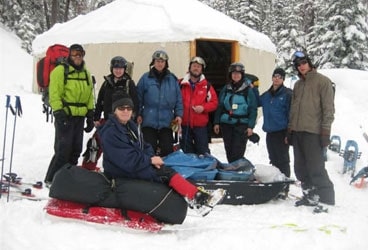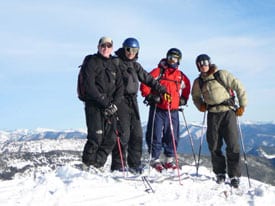
After too many years away at sea, Diana and I enjoy a Simon family reunion. Apparently in Montana these are never conducted in the comfort of one’s living room.
When my brother, Phillip, invited us to leave the Roger Henry in Alaska and come down to Montana, he never used the words “visit” or “vacation”. His mission was far more serious than a Christmas ham or a family frolic in the snow.
His passion, and that of his entire family, is backcountry skiing. They have embraced an “earn the turn” philosophy that eschews crowded ski resorts with their gondolas and chair lifts that do the hard hauling. They push into the wilderness, explore new drainages, skin up mountains and ski down through boulders, cliffs, stumps and streams. Carl Walenda, the famous tightrope walker, once said that life was a way of passing time between performances. For my brother it is between ski seasons. This passion has grown so significant in their lives that he wrote, “I want you to see what we do–who we are.”
As I was trudging my way up a steep and deep snowy mountain last week, I had time to reflect upon this idea that what we do is who we are. At first I rebelled at the notion. No! We are multi-faceted, and neither our vocation nor avocation alone should define us. But by the summit my argument had been blown away with the drifting snow.
The truth is that even though I may dabble a bit with various interests, these are but momentary diversions. My vocation, avocation, and reason d`etre are one. I sail, ergo I am a sailor.
Having failed to impress my family with my speed up the mountain, I hoped to vindicate myself on the downhill leg. Indeed, they were very impressed with my full front somersault, but suggested my next one should be intentional.
Chastened, on my next gasping slog up the mountain I asked myself, “Well, if you are willing to be defined by that one thing, you have to ask yourself if you are any good at it.”

Diana Simon| |From atop Morrell Mountain in the Lolo National Forest the wilds of western Montana spread out beneath us.| Our skill as cruising sailors is not as definable as racing sailors where fast is first. There is no finish line and no one is keeping score. So what exactly makes a cruising sailor “good”?
First, I determined that to sail safely is to sail well. “I’ve put a lot of water under my keel,” I thought. “And I haven’t lost my boat or my life.” That argument did not last until the next switch-back because some people, myself especially, are just plain lucky. I had to admit that I started out rather recklessly and ill prepared. Holding a plastic sextant in one hand and the instruction book in the other as the coast of Cuba ( I think) appears on the horizon does not qualify as meticulous preparation.
But, however slowly, I matured. I began to take the responsibility of command seriously and steadily developed my seamanship skills. I invested increasing amounts of time and money into the maintenance of the boat, it’s peripheral equipment, and especially the safety gear and procedures. Thirty years ago I would have had a hard time finding my harness and lanyard, now they hang in the companionway: it’s obligatory to hook on–end of discussion.
When Phil excitedly pointed to another mountain, even higher and steeper than the last, I knew I would have ample time to ponder the next topic, the process of sailing itself, for they once again left me for dead and it was up to me to catch up. When I wasn’t falling off the trail or plotting my revenge, I created a mental picture of the Roger Henry under sail. I replayed several of the thousand times Diana and I have hoisted, trimmed, reefed, furled or handed our sails. I critiqued our sail combinations, storm tactics and performance: running before huge seas, heaving to, or lying a-hull. I retraced our routes and their timings. I asked, “Have we shaped our voyages to efficiently harness the predictable forces of nature, yet adapted prudently to the unpredictable?”
Before the next downhill run I expressed some concern over the tight spacing of the trees on the precipitous slope. Phil said, “No problem, just ski around them.” I did–all but one.
By the fourth, and please God let it be the last ascent of the day, I realized just how far I have given myself over to cruising under sail. I live on a boat. I read about boats. I spend my spare time walking docks and yards looking for interesting boats. I dream of the sea and of grand voyages to come, and dread the thought of my final landfall.
That night, huddled around the wood stove in our yurt, my companions chatted casually using a nomenclature that was Greek to me. They discussed avalanche conditions, the nuances of varying snow types and their stacking, thermoclines, terrain traps, escape routes, ski types, telemark bindings versus all-terrain.
They were as immersed in this wilderness endeavor and as confident in their equipment, experience, and skills as I am with mine when sailing into the aching emptiness of the Big Blue.
This is what we do. For them it is the mountains, which Phil has shared with me. For me it is the sea, which I will share with him next summer via the coast of Alaska.
When I bent over to put another log in the fire I could not identify a single part of my body that did not hurt. When he visits the Roger Henry I think I will disable the windlass and have him haul the anchor chain by hand. And, of course, he gets the dogwatch.







